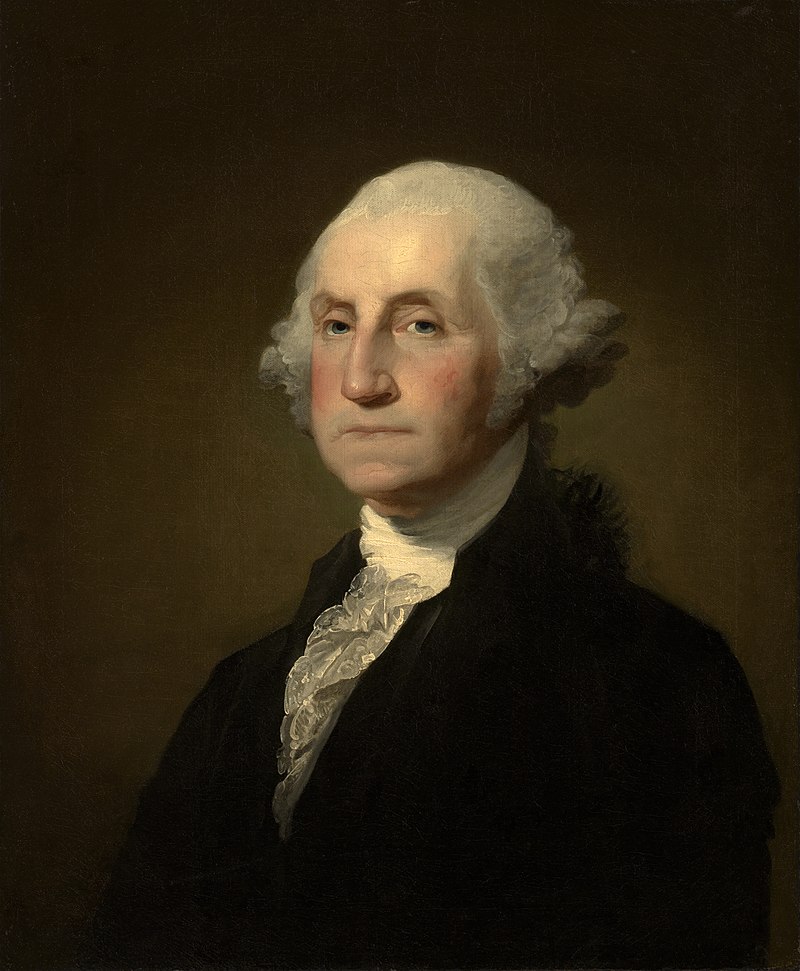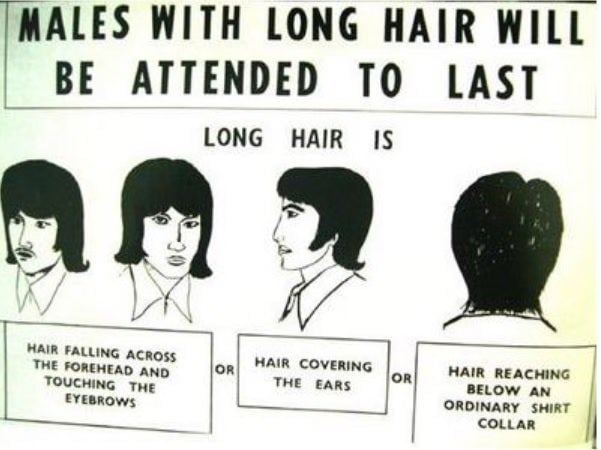Do you know that in Singapore, long hair was kind of banned for guys from 1972 all the way to the 1990s?
If you prefer to watch a video about this, here’s one we’ve done:
Prefer to read? Here goes.
A Summary of Why Long Hair Was Once “Banned” for Guys in Singapore
Before anything, let’s just say that it’s incorrect to associate guys with short hair.
What hairstyle we have currently is very dependent on cultural norms. For example, back in the past, it was common for guys to have super long hair.


And it’s not just in the Chinese culture; people in the west used to have long hair, too. Even the Founding Father of the US had long hair.


So it’s common for hairstyle to change through the years.
In fact, let’s just look at the last 20 years or so.
In the late 1990s to early 2000s, the trend for guys was to have centre-parting hair in Singapore.
Then, all of a sudden, Meteor Garden blew up. Back then, we only used the internet 36 hours a month, so our only source of entertainment was from the TV.
Meteor Garden is an idol drama featuring four guys who have long hair, so every Tom, Dick and Harry started to grow out their hair.


The trend didn’t last long, but you get the idea: guys’ hairstyle is like fashion, as they change as often as Taylor Swift changing boyfriend.
So, why was long hair kind of banned from 1972 to the early 1990s in Singapore? Because that sounded almost like the authorities banning a different type of fashion.
Well, for a start, you need to know what the heck happened in the 1960s to the 1970s.
The Hippie Culture That Started It All
In the 1960s, there was a countercultural movement called the hippie culture that started mainly in the US.
Countercultural movement is kind of like a group of people wanting a change, so they did the opposite of what is the social norm.
An example of a contemporary countercultural movement is the recent plant-based food movement. You see, for a long time, the cultural norm is that if we’re not vegan, we eat meat and vegetables.
But there are now people doing a countercultural movement to oppose that, advocating that we should eat just plant-based food instead, not just for religious or health reasons, but for sustainability and cruel-free living.
Now, whether you think it’s a good movement or not isn’t important in this video; you just need to know what a countercultural movement is.
Back in the 1960s, the countercultural movement called the hippie culture sought to counter a lot of social norms.
Back then, there were many countercultural movements, because societies all over the world, especially in the west, were undergoing many changes.
The hippie culture is one of them, and the goal is simple: they want peace as the US was involved in the Vietnam war, they want love, they want freedom and they want to live happily.
Now, that sounds good, doesn’t it?
Well, it can be, except for one thing: drugs.
A person who’s in the hippie culture is called a hippie. They have long hair, flowery shirts, bell-bottom jeans and have headbands. B
But here’s the thing: other than that, they were also associated with LSD and marijuana.
Yes, drugs.
If you think about it, the hippie culture is kind of okay, since they just want peace and love.
But when you add drugs in, they become a different group of people.
So, somehow, the movement spread to many in the US, and then it slowly spread overseas as well.
And when it spread to Singapore, that is when we started to take action, because remember: it was the late 1960s to 1970, and Singapore just gained independence.
Singapore’s Reaction to the Hippie Culture
In 1970, just five years after Singapore gained its independence, then Prime Minister Lee Kuan Yew was asked this question in an interview: “What tasks have already been resolved in your country and what are the immediate problems to be resolved in the near future?”
Back then, there were lots of challenges: NS was just introduced not too long ago, HDB was just starting to build bigger flats to solve the housing problems, we were still worried about our separation from Malaysia, our small domestic market was affecting our economy, unemployment was high and whatnot.
So you’d have bet that Mr Lee talked about one of them. Well, he did: the first task that he thought we had to address was the economic viability, saying that “The first task was to make ourselves economically viable,” which he added that “We are fortunately on the way towards achieving that.”
How about the immediate problem?
No, he didn’t talk about defence, Malaysia or even about housing. Instead, he said this: “The second point is the problem of being exposed to deleterious influences, particularly from the ‘hippie’ culture which is spreading across the jet routes.”
During that period, the world has started to globalise, and Singapore was starting to be exposed by other cultures.
Basically, he said that hippie culture spreading through air travel is a problem for Singapore. We were very open to outside influences because we’re an air and sea hub.
Things like songs, TV, and movies promoting escapism and drugs were a big threat to young people, so we needed to be strict to stop it and teach young people to resist these bad habits.
If we did not do so, it’ll ruin us like it did to some Western cities. In other words, Singapore was very serious about this.
And it’s not because the culture might be coming to Singapore; it had already reached Singapore.
There were people dressing up like hippies in Singapore, and local bands were leaning towards the hippie culture.
It’s akin to people wearing friendship bracelets when Taylor Swift came to Singapore.
Now, that seems harmless, right?
As mentioned, those are actually fine, except that hippies are also associated with drugs.
It doesn’t help that in the late 1960s, there was a bit of a drug problem in Singapore, mainly young people who go clubbing.
Soon, more students were caught taking drugs as time went by, so much so that in October 1971, Singapore set up the Central Narcotics Bureau (CNB) to tackle this problem.
The reason why more people were taking drugs was then attributed to the hippie culture.
Initially, the government tried to stop the hippie culture from influencing Singaporeans by kind of restricting certain songs in Singapore.
They also banned people who looked like hippies from entering Singapore.
But how did they do it?
Simple: it’s said that “dirty and untidy-looking people with long, unkempt hair and beard are presumed to be hippies unless proved otherwise.”
Other than stopping long-haired hippie-lookalike people from entering Singapore, long-haired male performers also could not perform on local TV and radio.
Soon, the ban spread from external to inside of Singapore.
How the Anti-Hippie Campaign Eventually Led to a Long Hair “Ban” for Men
Eventually, in January 1972, the campaign against long-haired guys was “targeted” at Singaporeans as well
The Ministry of Home Affairs then launched “Operation Snip Snip.”
For a start, all guys with long hair would be refused entry to Singapore, except for visitors invited by the government or “respectable organisations” for official business.
If you’re a Singaporean, you can still enter Singapore, but your passport will be taken away, and you can only collect it back when you’ve cut your hair.
Now, this was still not that serious until a few months later, when Operation Snip Snip went into overdrive.
This iconic poster was put up in all government offices.

You see, if you’re a guy with long hair, you’d be served last in the government office.
I know what you’re thinking: “Who cares? Who needs to go to government offices?”
Well, we can do everything with our SingPass now, but in the past, we needed to head to government offices to make any application with the government, so people usually had to head to government offices quite regularly.
If it’s still confusing, just think of it this way: if you’re a guy with short hair, you’ve SingPass Plus, which works like the SingPass you have now.
If you’re a guy with long hair, you’ve got SingPass Lite… with non-skippable ads promoting some stupid games that appear whenever you try to file any application with the government.
And that’s not all.
The government even discouraged employers from hiring long-haired men, and long-haired guys working for the government would also face disciplinary actions, including termination of service.
You can bet some people weren’t happy with the long hair ban, but if you think about it, it worked very well. Singapore is one of the countries with the lowest rates of illegal drug use, while the US, where hippie culture came from, has one of the highest rates of illegal drug use.
So when did this so-called long-hair ban end?
It actually went on for a while, but there were not many reports about it.
You see, the hippie culture slowly died off in the late 1970s, and there were no longer any news reports about long-haired guys.
While the Home Affairs Ministry said in 1986 that the ban hasn’t officially ended, it was reported much of the long-hair “ban” was no longer being enforced.
In 1993, the Ministry of Information finally lifted the restrictions on the songs that were restricted or banned during the anti-hippie campaign.
Many people therefore believe that this marks the complete lifting of the long-hair ban. Of course, whether stopping people from having long hair works in stopping drugs or not, we’ll never know.
Here’s a simplified summary of the South Korea martial law that even a 5-year-old would understand:

Read Also:
Advertisements

